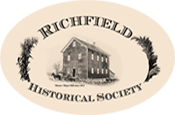Richfield's Claim to Tower Fame
Claim to Tower Fame - Susan Brushafer
The year was 1942 and history was being made. World War II was being fought. Bogart and Bergman heated the big screen in 'Casablanca. ' The Cardinals beat the Yankees in the World Series. 'Chattanooga Choo Choo,' recorded by Glenn Miller and his band, received the first RCA Victor gold record for selling 1.2 million copies. Milwaukee's broadcasting station .jpg) WTMJ, a pioneer in FM radio, built the Richfield Tower. That last bit of history should pique your curiosity!
WTMJ, a pioneer in FM radio, built the Richfield Tower. That last bit of history should pique your curiosity!
During the 1930s, broadcasting stations started experimenting with high fidelity radio, known to us as FM radio. Journal Communications, a Milwaukee-based newspaper publishing company, which started in 1882, had expanded into broadcasting. As early as 1939, the Journal Company applied for and received permission from the Federal Communications Commission (FCC) to erect an experimental FM transmitter. The station's transmitter, control rooms, studios, and workshop were located on the 22nd floor of the Wisconsin Tower, at 6th and Wisconsin Avenue in Milwaukee. On February 11, 1940, WTMJ put experimental FM station W9XAO on the air. It was said to be the first FM radio station west of the Allegheny Mountains, and was one of the first five FM stations in the country! The newness of FM radio, while intriguing to people, also meant that few living in Milwaukee actually owned FM 'radio sets.' Journal Communications helped solve that problem by purchasing 21 radio sets, and placing them around Milwaukee so that the public could listen.
.jpg) Both AM and FM grew in popularity, along with television. Responding to this growth, Journal Communications in1941 began constructing 'Radio City,' which included a 300-foot broadcasting tower at its new location at North Humboldt Blvd. and East Capitol Drive. (Over the years, Journal Communications went through a series of name changes and owners and is currently located at 333 W State Street. The station was relicensed in April 1941 as a commercial FM station on 45.5 MHz, with the call sign W55M. It broadcast music, two news breaks, and was on air for12 hours daily.
Both AM and FM grew in popularity, along with television. Responding to this growth, Journal Communications in1941 began constructing 'Radio City,' which included a 300-foot broadcasting tower at its new location at North Humboldt Blvd. and East Capitol Drive. (Over the years, Journal Communications went through a series of name changes and owners and is currently located at 333 W State Street. The station was relicensed in April 1941 as a commercial FM station on 45.5 MHz, with the call sign W55M. It broadcast music, two news breaks, and was on air for12 hours daily.
So, where does Richfield's claim to tower fame fit into this FM scenario?
In 1941 , Journal Communications built a 200-foot tower on Richfield Hill, a 450-foot elevation located just south of what is currently Richfield Elementary School. The tower complex included a two-floor brick building that housed living quarters for engineers/operators and was located 130 feet from the base of the tower. By 1948, W55M had become WTMJ-FM, and was the most powerful FM station in the United States thanks to the 50,000 watt transmitter in Richfield! It reached listeners as far west as Columbia and Dane counties and extended into parts of northern Illinois.
An article on WTMJ-FM, the World's First ' Super Power' FM Station, was published in the February 1949 issue of RCA's Broadcast News Magazine. It's worth noting this excerpt from that article in order to appreciate the Richfield Tower's local claim to fame.
"If WTMJ-FM were located in Milwaukee proper, some-forty to fifty percent of the area served wou1d be over the waters of Lake Michigan proper. By locating the transmitter fifteen miles inland, a land area of 18,000 square miles is being served. The population served, according to the 1940 census, is an estimated 2,432,000 people."
The entire RCA Broadcast News article, for those interested in details and pictures, can be found at http://fmamradios.com/WTMJ-FM.html
Unfortunately, in 1945 the FCC began hearings on a restructuring of the post-war radio bands. This was a setback for FM, and it would not recover from this restructuring for more than fifteen years. Post-war sales for new FM receivers were extremely slow, so on April 2, 1950, WTMJ-FM joined the growing list of dark FM stations. The Journal Company got back into the FM business in 1959.
History buffs, gain more information on-the growth of FM radio by 'tuning into' an article written by John Schneider, the Radio Historian: www.theradiohistorian.org/wtmjfrn.html
Hope you enjoyed this story
Enjoy our other stories

